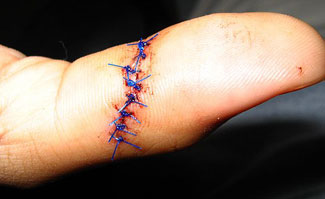Caring for Stitches (Sutures)

A wound of the skin is the result of an injury (like a laceration or cut) or surgery. A wound will either be left open to heal from the inside out, or it will be closed with stitches or sutures. Sutures, are threads, wires, or staples that close the edges of the skin around a wound to promote healing.
Doctors also close wounds with staples, glue, and butterfly bandages or Steri-strips. However, wound closures require a different type of follow-up care than sutures.
Proper Wound Care
Proper care of a wound allows it to heal without an infection. When you care for someone with any kind of stitch or wound closure, you need to know what a wound should look like and the steps to take to safely clean the wound.
Never try to remove a suture or wound closure. This could reopen a wound, damage tissue or cause an infection. The doctor will decide when it is time to remove sutures or any other wound closure.
Here is Mac’s Story:

My wife Louise had surgery for a large tumor in her abdomen. When she got home the doctor wanted us to keep the bandage on for 3 days and watch it. Then we were to remove the bandage and keep the wound clean. She had about 12 stitches in her belly; it was a pretty large incision. At first I was a bit nervous looking at the wound, but it really was not too bad. Louise was a trooper, she had no problem looking at it and that helped me. I made sure to look at the wound and the stitches each day. We kept a record of what we saw and then took it back to the doctor. Once Louise was allowed to clean the wound, she was allowed to shower. It healed pretty quickly. Louise is fine now.